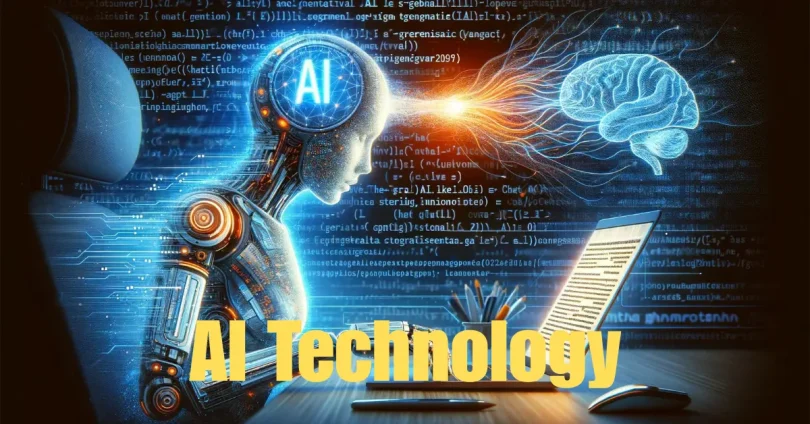Artificial Intelligence (AI) technology has become a pivotal force in transforming industries, improving productivity, and driving innovation on a global scale. AI involves creating machines that can mimic human intelligence, allowing them to perform tasks such as learning, problem-solving, perception, and decision-making.
This article provides an in-depth look at the fundamentals of AI technology, its various types, key components, applications, challenges, and its future potential.
What is AI Technology?

AI technology refers to the creation of computer systems capable of performing tasks that typically require human intelligence. These tasks include analyzing data, recognizing patterns, making decisions, and predicting outcomes based on available information. The core objective of AI is to enable machines to simulate human cognitive functions such as learning, problem-solving, and even emotional responses.
AI systems can process vast amounts of data, identify correlations, and use this information to optimize their actions over time.
The Evolution of AI Technology
AI technology has a rich history that dates back to the 1950s, when pioneers like Alan Turing and John McCarthy laid the foundation for the concept of machine intelligence. Turing’s groundbreaking work in computational theory and his famous Turing Test sought to determine whether a machine could exhibit intelligent behavior indistinguishable from that of a human.
In 1956, John McCarthy coined the term “Artificial Intelligence” during the Dartmouth Conference, which is considered the birth of AI as a formal field of study. Early AI systems were based on rule-based programming, where machines followed predefined rules to solve specific problems. However, AI began to evolve rapidly as researchers explored new approaches such as machine learning and neural networks.
By the late 20th century, AI began to integrate deep learning and big data techniques, enabling systems to handle increasingly complex tasks. Advancements in computational power, access to vast datasets, and improvements in algorithms have accelerated the development of AI, with today’s systems capable of achieving remarkable feats such as facial recognition, natural language processing, and autonomous decision-making.
You may also like to read this:
Top 10 Tech Innovations Transforming Industries In 2025
Latest Technology Trends In 2025 You Should Know About
The Future Of Technology And Innovation Explained
How Emerging Technologies Are Shaping The Future Of Work
The Best Smart Fitness Equipment For Every Workout
Top Recovery Technology For Data Protection 2025
Types of AI Technology

Artificial Intelligence (AI) technology can be broadly categorized based on its capabilities into Narrow AI (Weak AI) and General AI (Strong AI). These categories reflect the scope of intelligence that an AI system can exhibit, from highly specialized tasks to achieving human-like cognitive abilities.
1. Narrow AI (Weak AI)
Definition: Narrow AI refers to systems that are designed to handle specific tasks or a set of tasks. These systems are highly efficient at performing their designated functions but are not capable of generalizing knowledge or learning beyond their programmed domain. The intelligence exhibited by Narrow AI is limited to the specific problem it was designed to solve, making it different from human-like versatility.
Characteristics:
- Task-specific: Narrow AI is designed to solve one particular problem efficiently.
- Limited scope: It operates within predefined parameters and cannot adapt to tasks outside of its original design.
Examples:
- Voice Assistants: Popular examples include Siri, Alexa, and Google Assistant. These systems can perform tasks such as setting reminders, answering questions, or controlling smart devices. However, their capabilities are limited to predefined functions and they cannot perform tasks beyond their programming.
- Recommendation Systems: Platforms like Netflix and Amazon use AI to analyze user preferences and recommend movies, products, or services. These systems learn from user behavior but cannot provide recommendations outside the scope of their respective domains.
- Self-Driving Car Algorithms: AI used in autonomous vehicles, such as Tesla’s Autopilot, is designed to navigate roads, detect obstacles, and follow traffic laws. However, it operates within a specific domain, limited to driving tasks, and cannot generalize to other activities.
2. General AI (Strong AI)
Definition: General AI, also referred to as Strong AI, represents the theoretical and long-term goal of AI research. It involves creating machines that possess the ability to understand, learn, and perform any intellectual task that a human can do. General AI would exhibit true cognition and be capable of adapting to new situations and tasks independently, much like a human.
Characteristics:
- Autonomy: General AI would learn autonomously and apply its intelligence across various domains without human intervention.
- Cognitive abilities: It would possess the capacity to reason, make decisions, solve complex problems, understand emotions, and even display creativity.
- Adaptability: General AI would adapt to new tasks and environments as it encounters them, demonstrating learning and decision-making capabilities beyond predefined programming.
Examples:
Currently, General AI does not exist in practical form. It remains a long-term aspiration in AI research. A fully realized General AI would be capable of performing complex tasks across various domains such as:
- Healthcare: Providing medical diagnoses, treatment recommendations, and managing health records with complete understanding.
- Legal profession: Analyzing legal documents, advising clients, and representing them in court.
- Creative industries: Writing novels, composing music, creating visual art, and contributing innovatively in artistic fields.
Key Components of AI Technology
AI technology relies on various core components that enable systems to perceive, process, learn, and make decisions. These key components are foundational in enabling machines to exhibit intelligent behavior.
1. Machine Learning (ML)
Definition: Machine learning is a subset of AI that allows systems to automatically learn from data and improve their performance over time without being explicitly programmed. Instead of relying on hard-coded rules, ML algorithms identify patterns within the data and make predictions or decisions based on those patterns.
Types of Machine Learning:
- Supervised Learning: The model is trained using labeled data where the correct output is already known. This allows the model to learn the relationship between input data and output labels, making it capable of making predictions or classifications on new, unseen data.
- Example: Email spam filters that classify messages as “spam” or “not spam” based on labeled training data.
- Example: Email spam filters that classify messages as “spam” or “not spam” based on labeled training data.
- Unsupervised Learning: The model learns from data that is unlabeled and seeks to identify hidden patterns or structures within the data. It does not have predefined output labels to guide the learning process.
- Example: Customer segmentation in marketing, where the algorithm identifies groups of customers based on their purchasing behavior without predefined categories.
- Example: Customer segmentation in marketing, where the algorithm identifies groups of customers based on their purchasing behavior without predefined categories.
- Reinforcement Learning: This approach involves training a model through trial and error. The model takes actions in an environment, receives feedback in the form of rewards or penalties, and learns to optimize its actions to maximize cumulative rewards.
- Example: AI in gaming (such as AlphaGo) or robots learning to perform tasks by interacting with their environment.
2. Deep Learning
Definition: Deep learning is a subset of machine learning that uses neural networks with many layers (hence the term “deep”) to model complex patterns and representations in data. Deep learning is especially effective in tasks involving large datasets and complex structures, such as image and speech recognition.
Characteristics:
- Neural Networks: Deep learning networks consist of layers of neurons that mimic the functioning of the human brain. These networks learn to recognize patterns in data through training on large datasets.
- Large-scale data handling: Deep learning is capable of processing massive amounts of data, making it ideal for tasks like image classification, voice recognition, and natural language processing.
Examples:
- Facial Recognition: AI systems use deep learning to analyze facial features from images and videos, enabling applications in security and authentication.
- Voice Assistants: Deep learning enables AI assistants like Alexa and Google Assistant to process and interpret spoken language, providing responses that sound natural and contextually relevant.
- Self-Driving Cars: Deep learning algorithms in autonomous vehicles process sensor data (such as cameras, LiDAR, and radar) to interpret and navigate the car’s environment.
3. Natural Language Processing (NLP)
Definition: Natural Language Processing (NLP) is the field of AI that focuses on the interaction between computers and human language. NLP enables machines to understand, interpret, and generate human language in ways that are meaningful and contextually appropriate.
Applications:
- Translation Tools: Services like Google Translate use NLP to convert text from one language to another.
- Chatbots and Virtual Assistants: Systems like Siri, Alexa, and Google Assistant rely on NLP to interpret user queries and respond naturally.
- Sentiment Analysis: NLP is used in social media monitoring tools to analyze the sentiment (positive, neutral, negative) of user-generated content like posts or reviews.
4. Computer Vision
Definition: Computer vision allows machines to interpret and understand visual data such as images and videos. It enables AI systems to recognize objects, detect faces, read text, and track movements.
Examples:
- Facial Recognition Systems: AI-powered systems used in security and authentication analyze facial features for identification.
- Autonomous Vehicles: Self-driving cars use computer vision to interpret visual data from cameras and sensors, enabling them to navigate roads safely.
- Medical Imaging: AI assists doctors in analyzing medical scans (such as X-rays, CT scans, and MRIs) to detect diseases like cancer.
5. Robotics
Definition: Robotics combines AI with physical machines to create autonomous robots capable of performing a wide range of tasks in real-world environments. AI enhances a robot’s ability to perceive its environment, navigate, and interact with objects.
Examples:
- Industrial Robots: AI-powered robots are used in manufacturing to automate tasks such as assembly, packaging, and quality control.
- Robotic Vacuum Cleaners: Devices like Roomba use AI algorithms to map a home, navigate around obstacles, and clean floors autonomously.
- Surgical Robots: Robotic systems used in medicine help surgeons perform highly precise procedures with minimal invasiveness.
Applications of AI Technology
AI is reshaping a wide range of industries, driving innovations that improve efficiency, personalize user experiences, and transform the way businesses operate.
1. Healthcare
AI is improving diagnostics, personalized treatment, and drug discovery:
- Medical Imaging: AI systems analyze medical scans (X-rays, MRIs) to detect diseases, improving early detection and treatment accuracy.
- Drug Discovery: AI is accelerating the identification of potential drug candidates by analyzing massive datasets, potentially leading to faster drug development.
- IBM Watson for Health: Watson helps doctors analyze patient data to make more accurate treatment decisions.
2. Finance
AI is revolutionizing the finance industry through automation, fraud detection, and personalized investment advice:
- Fraud Detection: AI models detect unusual patterns in transaction data to identify potential fraud.
- Robo-Advisors: AI-powered platforms offer personalized investment strategies based on user preferences and financial goals.
3. Autonomous Vehicles
Self-driving cars use AI to make decisions in real time:
- Tesla’s Autopilot: Uses AI to navigate roads, detect obstacles, and follow traffic laws without human input.
- Waymo: Alphabet’s subsidiary working on fully autonomous vehicles, leveraging AI for efficient and safe transportation.
4. Retail and E-commerce
AI enhances the customer experience by providing personalized recommendations and optimizing inventory management:
- Recommendation Systems: Amazon and Netflix use AI to suggest products and content based on individual preferences.
- AI Chatbots: Customer service chatbots improve efficiency and customer satisfaction by providing instant responses.
Challenges and Ethical Considerations
As AI technology advances, it introduces new challenges and ethical dilemmas:
- Bias in AI: AI systems can inherit biases from their training data, leading to discriminatory outcomes. Ensuring fairness and addressing bias in AI algorithms is crucial.
- Privacy Concerns: AI requires vast amounts of data, raising concerns about personal privacy and data protection.
- Job Displacement: Automation through AI could replace jobs in certain industries, creating a need for reskilling programs to help workers transition to new roles.
- Autonomous Weapons: The use of AI in military applications, such as autonomous weapons, raises concerns about accountability, control, and unintended consequences.
The Future of AI Technology
AI is expected to play an even more significant role in solving global challenges such as climate change, healthcare, and economic disparities. Researchers are also focused on developing explainable AI to make AI decision-making processes more transparent and understandable. The long-term goal remains the development of General AI, which would exhibit cognitive abilities comparable to humans, capable of performing any intellectual task autonomously.
As AI continues to evolve, it promises to unlock vast opportunities, making our lives more efficient, personalized, and connected. However, responsible development, regulation, and ethical considerations will be essential to ensuring AI benefits society as a whole.
Conclusion
AI technology is transforming industries and has the potential to revolutionize the way we live and work. While the technology holds great promise, it also raises significant ethical, social, and economic concerns. To ensure that AI benefits society, it is essential to develop AI systems responsibly, with attention to fairness, transparency, and accountability.
The future of AI technology is bright, but its development must be guided by ethical principles and a focus on improving human welfare.
FAQs
1. What is Artificial Intelligence (AI)?
Artificial Intelligence (AI) refers to the simulation of human intelligence in machines that are programmed to think and learn like humans. These machines can perform tasks such as problem-solving, decision-making, language processing, and visual perception.
2. What are the different types of AI?
AI can be classified into two main types:
Narrow AI (Weak AI): This type of AI is designed to perform specific tasks, such as facial recognition or voice assistants (e.g., Siri, Alexa). It is limited to a predefined set of activities.
General AI (Strong AI): This is a theoretical form of AI that can understand, learn, and apply knowledge across a broad range of tasks, much like a human.
3. How does Machine Learning (ML) differ from AI?
Machine Learning (ML) is a subset of AI. While AI refers to creating machines that simulate human intelligence, ML focuses specifically on algorithms that allow computers to learn from data and improve over time without explicit programming.
4. What is deep learning, and how is it related to AI?
Deep learning is a subset of machine learning that uses neural networks with many layers (deep networks) to analyze and learn from large datasets. It has been particularly successful in tasks like image and speech recognition, and it plays a crucial role in advancing AI capabilities.
5. What are some practical applications of AI?
AI is used in various industries for a wide range of applications, including:
Healthcare: Diagnostics, personalized treatments, and robotic surgeries.
Finance: Fraud detection, algorithmic trading, and customer support.
Automotive: Autonomous vehicles and driver-assistance systems.
Retail: Personalized shopping experiences, recommendation engines.
Entertainment: Content recommendations on platforms like Netflix and Spotify.
Manufacturing: Predictive maintenance, automation, and quality control.



